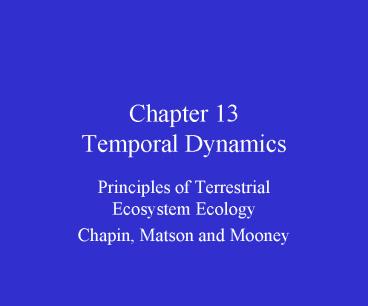Chapter 13 Temporal Dynamics - PowerPoint PPT Presentation
1 / 29
Title:
Chapter 13 Temporal Dynamics
Description:
Ecosystems are always responding to change. and disturbance. ... Relict tallgrass prairie found in Boulder! The grasslands. WERE the. largest biome. type in ... – PowerPoint PPT presentation
Number of Views:71
Avg rating:3.0/5.0
Title: Chapter 13 Temporal Dynamics
1
Chapter 13Temporal Dynamics
- Principles of Terrestrial Ecosystem Ecology
- Chapin, Matson and Mooney
2
Ecosystems are always responding to change and
disturbance. Their ability to resist change is
called resistance Their ability to recover from
change is called resilience. During succession,
the amount of resistence and resilence can
vary (e.g., response to fires, beetles, etc)
3
(No Transcript)
4
- Fire effects
- Types of fire
- surface,
- crown,
- ground
- a) cool,
- b) hot,
- c) sterilizing/extreme)
5
Fire return intervals (Aber and Melillo 1991)
6
(No Transcript)
7
Fire return intervals Aber and Melillo 1991)
The most fire- prone ecosystem in North
America was in the semi- humid zone!!!
8
Fire return intervals Aber and Melillo 1991)
Right next to the Most fire-prone ecosystem is a
system with a 200-400 year fire return
interval. Whats up with that? Why the huge
difference In return intervals?
Right next to the most fire-prone ecosystem in
North America was a system with a 200-400 year
return Interval. Whats up With that?
9
Summary Longest fire return intervals
asbestos forest of New England Chihuahuan
desert Shortest return tallgrass prairie 2-4
yrs Front Range Foothills (7-12) Chaparral
shrubland (10-20) Southeastern wire grass
(30-60) Note that areas that had short fire
return Intervals have large human densities
10
Probability of Fire Fuel load (1-
Moisture) (fuel load time since last fire?)
Probability of fire (red)
Wet
Dry Dryness
Fuel Load
11
wet
Wet, low fuel (a lake!)
wet, high fuel The asbestos forests
Moisture index
Highest Fire return intervals
Any ecosystems Over here dont Last long!
Dry, low fuel (desert)
dry
Zero
lots
biomass Fuel Index (Note that very dry
systems rarely have large biomass!)
12
Within a particular ecosystem type Time since
last fire may also predict fuel load (this
would be a life-form characteristic,
different for forest, shrublands, and
grasslands) Prob of fire time since last fire
13
Fire return intervals (Aber and Melillo 1991)
14
Many ecology texts mistakenly put the Eastern
Deciduous Forest into areas that were in fact
grasslands!
Relict tallgrass prairie found in Boulder!
15
(No Transcript)
16
The grasslands WERE the largest biome type
in the lower 48.
17
(No Transcript)
18
(No Transcript)
19
(No Transcript)
20
Spring emergence of plants is delayed by the
insulation effects of standing dead grass litter.
21
(No Transcript)
22
(No Transcript)
23
Greater NPP but the same/lower N means higher CN
ratios of plant materials. What does this
predict about N mineralization?
Site 2
Site 1
24
(No Transcript)
25
C4 grasses not only out-compete C3 species in
this environment, they create a positive feedback
IN GREAT PLAINS
- High fire frequency
- low N availability,
high light, low water - C4 grass species dominance (high CN, high NUE),
High NPP
26
Data from Jenny
27
- Fire effects
- species composition
- survivorship
- seed bank response
- b) resource availability
- 1. Light
- 2. Moisture
- 3. Nutrients
- a. volatile elements
- b. ash elements
28
The role of fire in maintaining
grasslands wasnt documented until the late
1940s (and even Aldo Leopold failed to
understand the role of fire) Up until then, you
could prevent fires and grasslands would remain
grasslands. Somethings changed in the last 60
years???
29
- Fire effects on nitrogen availability
- Amount up in smoke
- 2. Effects on availability in soil
- A) CN ratio of detritus and soil?
- B) Microbial response































